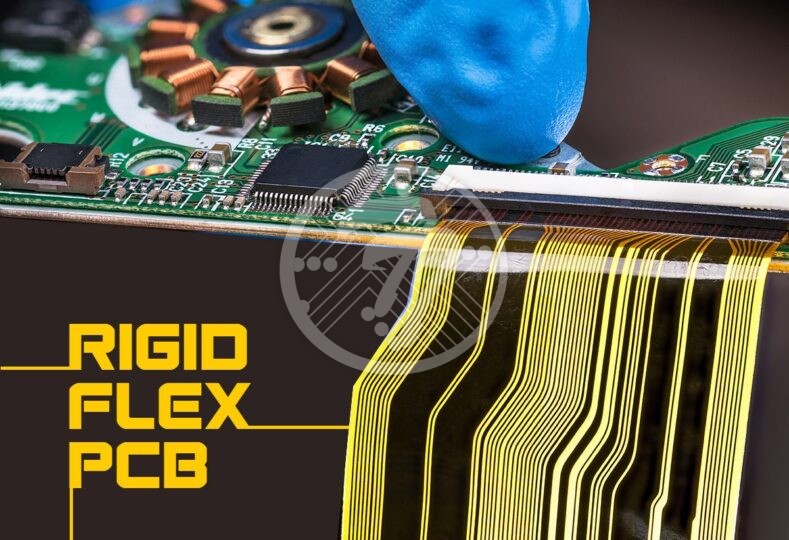Top things you need to know about the Rigid-Flex PCB Manufacturing Process!

Rigid-flex PCBs are extremely popular as they combine the characteristics of rigid as well as flexible PCBs. Essentially, they layer flexible circuit substrates inside rigid circuit board materials. What it offers, therefore, is the stability and strength of rigid PCBs along with the versatility of flexible circuits. The combination of rigid-flex PCB manufacturing opens a wide range of possibilities when it comes to complex and challenging designs. What it also offers is improved service reliability and performance.
Rigid-Flex circuit boards find wide use in commercial and industrial applications including but not limited to:
- Military
- Aerospace
- Digital Cameras
- Cell Phones
- Pacemakers
- Barcode scanners and more
Advantages of Rigid-Flex PCBs
Some of the specific advantages that rigid-flex PCBs offer include:
- Stability – With their structure comprising of interchanging layers of rigid and flexible PCBs they offer mechanical stability. They also lend themselves to easy installation in small spaces.
- Reliability of connections – Rigid-flex PCBs offer increased stability as well as polarity. This leads to reliable connections.
- Cost effectiveness – Rigid-flex PCBs are extremely cost-effective and ensure that your project is viable.
- High-density applications – With miniaturization and high-density applications growing in popularity so is the use of rigid-flex PCBs.
- High shock and vibration resistance – Rigid flex PCBs are resistant to shock and vibration and find a place in a wide variety of applications.
Rigid-Flex PCB Design Guidelines
While the advantages of rigid-flex PCBs are well-documented, there are several design guidelines that need to be followed when it comes to manufacturing these PCBs. These include:
1. Determine The Number of Layers
Rigid-flex PCBs are made of alternating layers of flexible and rigid PCB Material. It is therefore important to figure out the exact layer count that is required. It is prudent to consult your electronics contract manufacturer early to ensure that all the requirements can be met.
2. Heat Sinking
Due importance needs to be given to having a heat dissipation mechanism in place. In the absence of it, the device performance can be impacted, and it may also result in damage to the device. The PCB needs to facilitate heat sinking.
3. Material Layup
Layup of materials is yet another crucial factor. This includes checking for:
- The UL flammability rating
- Minimum bend radii needed
- RoHS certification
- Impedance control
- Mechanical considerations, and more.
Material layup, in turn, impacts both cost as well as manufacturability.
Steps Involved in Rigid-Flex PCB Manufacturing Process
The rigid-flex PCB manufacturing process involves the following steps:
Base Preparation
This involves preparation of the laminate. The laminate, in turn, features a copper layer. If the copper contains anti-tarnish, it needs to be removed by immersing it in acid solution.
Circuit Patterns / Structure
Through a process of either photo imaging or screen printing, circuit patterns are generated.
Circuit Pattern Etching
Etching the circuit pattern is largely done by spraying a solution over the circuit pattern or dipping the laminate in an etching solution. Etching is then undertaken on both sides of the circuit pattern.
Drilling Holes
Holes are next drilled using lasers. Laser drilling, in turn, assures precision as well as minimizes waste.
Through-hole Plating
Copper is deposited into the drilled holes and plated with a chemical. This step is crucial to create electrical interconnections.
Coating Etch-Resist and stripping
This step involves applying a photosensitive etch-resist coating on the substrate. The chemical resist applied to the plated through-hole is next stripped.
Cover lay Application
A cover lay is applied to the PCB to protect it from harsh environmental conditions. The coverlay material is screen printed onto the surface of the circuit board and exposed to UV.
Cutting the Flex
The individual flex board is now cut from the production panel with extreme caution and precision.
Lamination
In this step, the flexible printed circuit boards is laminated between the rigid sections.
Electrical Testing and Verification
Electrical testing and verification are the final step that ensures circuit performance and quality.
With the above steps you can rest assured that you will get a performance-driven rigid-flex PCB. The important bit is to choose a contract manufacturer that specializes in the fabrication of rigid-flex PCBs, who can understand your bespoke requirements and deliver accordingly.
As a leading rigid-flex PCB manufacturer, we are fully equipped to handle your PCB manufacturing requirements. With over 4 decades of experience in rigid-flex PCB manufacturing as well as assembling PCBs with differing levels of complexities, our team of experts & state-of-the-art equipment ensures that all our PCBs meet the industry standards of quality.
In case if you have any questions or queries regarding our rigid-flex PCB manufacturing services, please feel free to contact us via email at [email protected] or call us at 714/630-9200.






